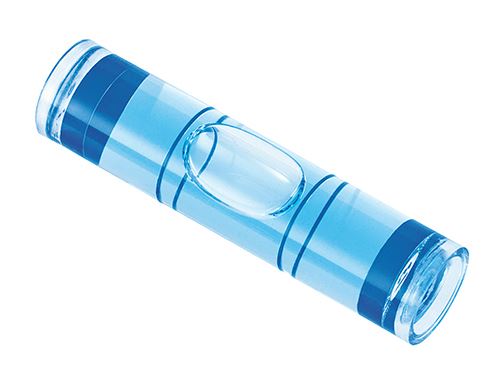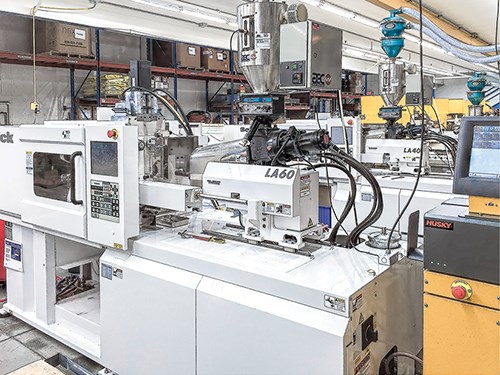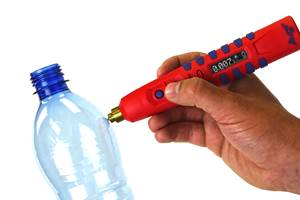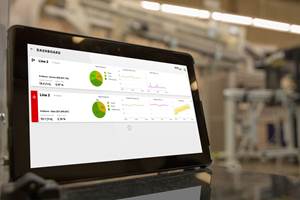Two-Stage Injection Meets Molder’s Need for High Precision
Fixed screw and plunger with no check ring hold tolerances of millionths of an inch.
A carpenter can’t do a proper job without the right tools, and the same goes for an injection molder. One essential tool for building contractors is a carpenter’s level, and molding critical parts for that device, it turns out, requires a special type of injection machine.
Empire Level in Mukwonago, Wis., is a leading designer and producer of levels, squares, and layout tools since 1919. A carpenter’s level may seem like a simple instrument, but manufacturing it is far from simple. Tom Foran, operations manager for plastics at Empire, notes that the vial with the “bubble” in a level is a cylinder of impact acrylic plus a cap.
They are molded, the vial is filled, the cap is welded on, and then the vial is decorated with the appropriate markings. Foran describes the inside of the vial as “football-shaped,” requiring ejection off an undercut. The internal arc in the vial has a 9-in. radius, with required accuracy of 0.0005 in./in.; and other tolerances on the 19/16–in.-long part are as small as ±60 millionths of an inch. The cap, which includes an energy director for ultrasonic welding, has tolerances of ±0.002 in.
The result, says process technician Chris Lathrop is “an extremely narrow process window for filling and packing.” Empire makes 18 million of the vial assemblies per year, using automatic cavity separation, and performs quality checks with a submicron coordinate measuring machine (CMM) and a vision system.
Using conventional horizontal injection machines, Empire Level had experienced unacceptably high internal reject rates. In 2014, the firm decided to purchase new presses. Foran was familiar with Sodick injection machines from Japan. Evaluating these presses against two other brands produced a clear conclusion: “The other competitors never stood a chance.”
The key was Sodick’s two-stage injection system, with a fixed screw feeding a plunger in a “V” arrangement. This eliminates the check valve that Foran considers to be the Achilles heel of most injection presses. Small differences in valve-closing time lead to variations in cushion volume, shot size, and fill rate. “The 0.1 sec it takes for a check ring to seal can make the difference between a good day of molding and a really bad one,” Foran comments.
He adds that with conventional presses, offgassing of the resin necessitated weekly teardowns for cleaning. But use of a non-reciprocating screw with no check valve has resulted in less shear on the resin and thus less offgassing and downtime for maintenance.
“An obstacle was the higher cost of this specialized machine,” Foran says. “But if you look at the entire package—the quality, accuracy, technical support, and training we received made it an easy decision. The machine essentially paid for itself in fewer rejects.
In August 2014, Empire Level bought two Sodick horizontal presses from Plustech, Inc., the North American branch of Sodick’s injection machine division, in Schaumburg, Ill. The press sizes were 40 tons with 14 cc shot size and 60 tons with 27 cc shot capacity. In October 2015, Empire added a Sodick 100-ton model with 251 cc shot size.
All three machines have a hybrid clamping system with servo-driven mold traverse, mechanical lock, and servo-hydraulic pump for mold closing and injection. Lathrop says servo-hydraulics have definite advantages, such as shorter valve reaction time (12 millisec) than for the all-electric presses Empire has examined.
Also, Lathrop says all-electrics “can’t handle the duty load of our process, which requires 20,000 psi fill pressure for 15-20 sec, and some products have long hold times.”
Related Content
Inline Inspection System for Wood Plastic Composites
Pixargus’ ProfilControl 7 DX WoodPlasticComposites measure all dimensions and geometrics, including deep grooves.
Read MoreTracing the History of Polymeric Materials -- Part 30: Polyurethane
In the world of polymers, polyurethane chemistry is probably the most versatile. This a resulted in a wide range of products made from these materials and given the industry the flexibility to respond to the progressive march of regulatory concerns.
Read MoreDual-Mode Portable Thickness Gauge for Packaging
Hand-held “pen” measures sheets, containers, panels, large parts with magnetic or capacitance mode; controlled by Bluetooth phone app.
Read MoreHow Inline Vision Inspection Can Minimize Scrap in Molding
Once viewed by injection and blow molders as a necessary evil, machine vision technology today can continuously monitor and improve production while reducing costs.
Read MoreRead Next
Lead the Conversation, Change the Conversation
Coverage of single-use plastics can be both misleading and demoralizing. Here are 10 tips for changing the perception of the plastics industry at your company and in your community.
Read MoreUnderstanding Melting in Single-Screw Extruders
You can better visualize the melting process by “flipping” the observation point so that the barrel appears to be turning clockwise around a stationary screw.
Read MoreHow Polymer Melts in Single-Screw Extruders
Understanding how polymer melts in a single-screw extruder could help you optimize your screw design to eliminate defect-causing solid polymer fragments.
Read More

























